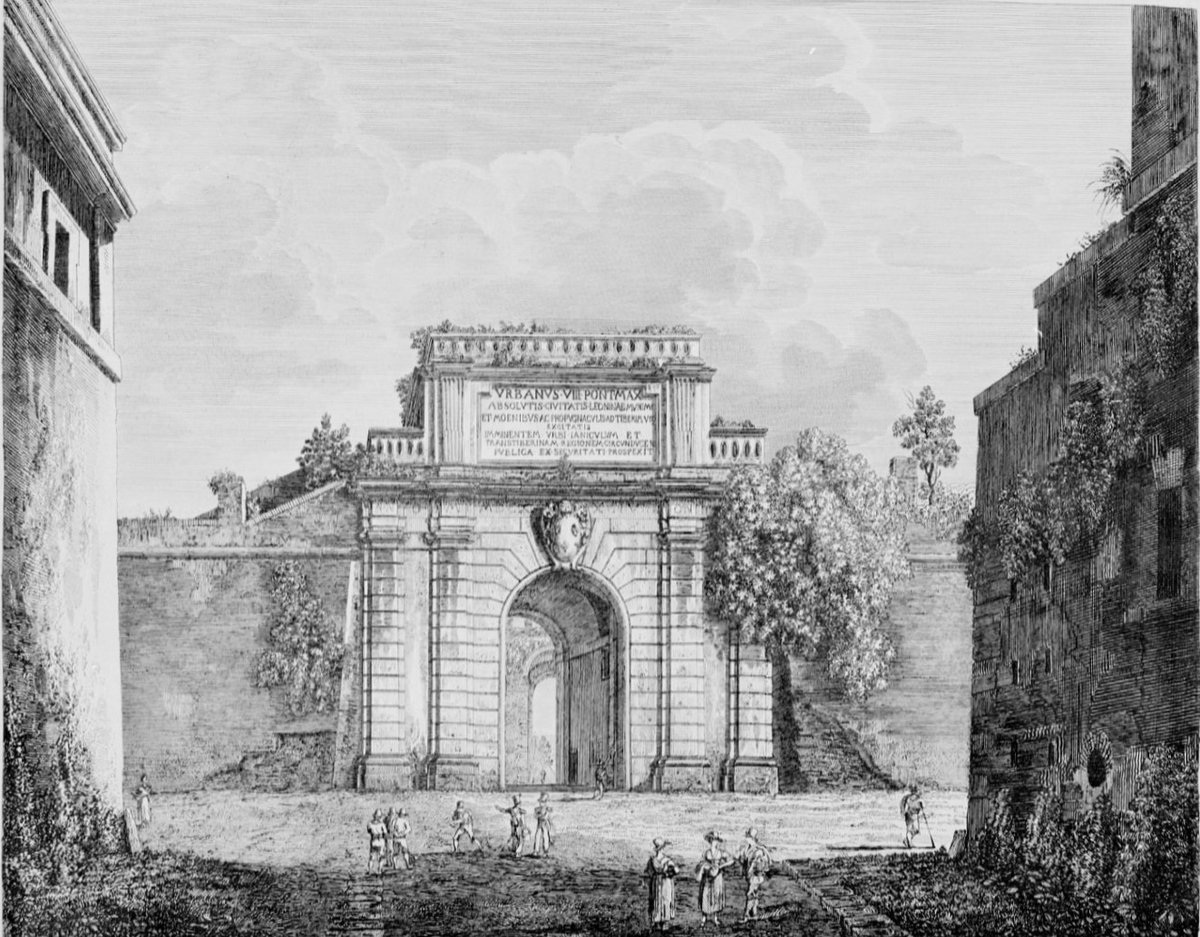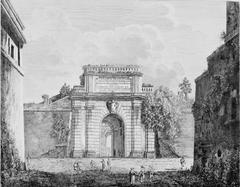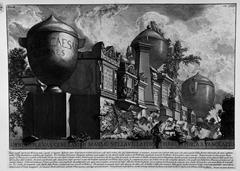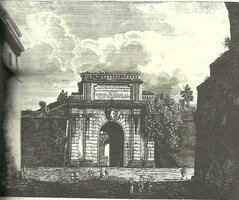
Porta San Pancrazio: Visiting Hours, Tickets, and Historical Sites in Rome
Date: 14/06/2025
Introduction
Porta San Pancrazio stands as a testament to Rome’s layered history, serving as both a physical gateway and a symbol of the city’s enduring spirit. Located atop the scenic Janiculum Hill, this monumental gate has witnessed centuries of transformation—from its ancient origins as Porta Aurelia through its pivotal role in the Italian Risorgimento, to its present-day function as a museum and memorial. Whether you are a history enthusiast, a cultural explorer, or a visitor seeking panoramic views of the Eternal City, Porta San Pancrazio offers a unique window into Rome’s past and present (romeartlover.it; museodellarepubblicaromana.it; aarome.org; turismoroma.it).
Table of Contents
- Ancient Origins and Roman Era
- Early Christian and Medieval Developments
- The Gate’s Role in Rome’s Defenses
- The Risorgimento and Battles of 1849
- Reconstruction and Modern Memorialization
- Architectural Features and Surroundings
- Visitor Guide: Tickets, Hours, and Accessibility
- Nearby Attractions
- Frequently Asked Questions (FAQ)
- Conclusion
- References
Ancient Origins and Roman Era
Porta San Pancrazio began its story as Porta Aurelia, a vital point along the Via Aurelia that connected Rome to the western territories and the Tyrrhenian coast (romeartlover.it). Built originally in the late Republic (circa 50 BCE), the gate was integrated into the Aurelian Walls under Emperor Aurelian (270–275 CE), reflecting Rome’s strategic need for robust defenses as external threats increased (jeffbondono.com). The Via Aurelia’s significance for trade, military movement, and pilgrimage made this gate a crucial urban threshold.
Early Christian and Medieval Developments
With the rise of Christianity, the area surrounding the gate gained spiritual importance. The nearby Basilica di San Pancrazio, constructed over the catacombs of Saint Pancras, became a prominent pilgrimage site (catacombeditalia.va). The gate adopted the saint’s name, symbolizing the merging of Rome’s religious and urban identities. During the Middle Ages, the vicinity was economically active, with mills powered by the Acquedotto di Traiano, underscoring the gate’s continued relevance to the city’s livelihood (rome-roma.net).
The Gate’s Role in Rome’s Defenses
Porta San Pancrazio was repeatedly at the center of military action. During the Gothic War in 537 CE, Ostrogothic forces besieged the city and assaulted the gate, exposing its strategic vulnerabilities (jeffbondono.com). In the 17th century, Pope Urban VIII, responding to new military threats, commissioned the construction of the Gianicolense Walls and the Baroque-era gate designed by Marcantonio De’ Rossi (1642–1644) (romeartlover.it). This new fortification shifted the gate’s location and introduced massive bastions, reflecting innovations in military architecture.
The Risorgimento and Battles of 1849
Porta San Pancrazio’s most defining moment came during the Italian Risorgimento. In 1849, as the Roman Republic fought to defend its ideals against French intervention, the gate became the focal point of fierce combat under Giuseppe Garibaldi’s leadership (turismoroma.it). The resulting bombardment left the gate in ruins, but the defenders’ valor became legendary in the narrative of Italian unification.
Artifacts and stories from this era are preserved in the Museo della Repubblica Romana e della Memoria Garibaldina, now housed within the reconstructed gate, offering insight into the sacrifices made for national unity (romeartlover.it).
Reconstruction and Modern Memorialization
Between 1854 and 1857, architect Virginio Vespignani rebuilt Porta San Pancrazio under Pope Pius IX. Echoes of previous architectural phases remain, and inscriptions mark its restoration. The gate played a further historic role in 1870, as Italian troops entered Rome through it, signaling the end of the Papal States and the city’s unification with Italy (rome-roma.net).
Since 2011, the upper floors of Porta San Pancrazio have housed the Museo della Repubblica Romana e della Memoria Garibaldina, commemorating both the 1849 struggle and later anti-fascist resistance (museodellarepubblicaromana.it). The nearby Mausoleo Ossario Garibaldino inters the remains of over 1,600 patriots, including Goffredo Mameli, further cementing the area’s status as a site of remembrance (turismoroma.it).
Architectural Features and Surroundings
The current gate is a rectangular structure of travertine and brick, with a central archway and commemorative plaques referencing the 1849 battles and subsequent restoration (romanoimpero.com). Coats of arms of Pope Urban VIII and Pope Pius IX, as well as a 17th-century coat of arms by Gian Lorenzo Bernini, adorn the walls (romeartlover.it). The Gianicolense Walls, with their commanding views over Rome, integrate the gate into a network of historical villas and gardens, such as Villa Spada and Villa Doria Pamphilj.
Proximity to the Basilica di San Pancrazio and its catacombs adds a spiritual dimension, making a visit to the gate a multifaceted historical and cultural experience (catacombeditalia.va).
Visitor Guide: Tickets, Hours, and Accessibility
Opening Hours
- Museo della Repubblica Romana e della Memoria Garibaldina:
- Tuesday to Sunday: 9:00 AM – 7:00 PM (last entry at 6:30 PM)
- Closed Mondays and select holidays
- Always check the official website for updates.
Tickets
- Admission: Modest fee; discounts for EU citizens (18-25), free for under 18s and eligible residents/students.
- Purchase: On-site or online via museum/official tourism platforms.
Accessibility
- General: Ground floors and some pathways are accessible; upper floors may require stair access.
- Assistance: Contact the museum ahead for accessibility arrangements.
Getting There
- Bus: ATAC lines 44, 75, 870, and 982 stop close to Porta San Pancrazio (ATAC website).
- Tram: Tram 8 to Trastevere, then a 15–20 minute walk uphill.
- Taxi/Walking: Taxis are readily available; walking from Trastevere or the Vatican area is feasible.
- Parking: Limited and mostly reserved for residents; use paid parking in Trastevere or Monteverde.
Nearby Attractions
- Villa Doria Pamphilj: Rome’s largest landscaped park, perfect for walks, picnics, and outdoor activities (ItalyGuides).
- Janiculum Hill (Gianicolo): Offers panoramic views of Rome and is adorned with monuments and statues commemorating Garibaldi and the Risorgimento.
- Basilica di San Pancrazio and Catacombs: Important pilgrimage destination (catacombeditalia.va).
- Trastevere District: Famed for its lively streets, authentic Roman cuisine, and vibrant nightlife.
Frequently Asked Questions (FAQ)
Q: What are the current visiting hours for Porta San Pancrazio and its museum?
A: Tuesday to Sunday, 9:00 AM to 7:00 PM; closed on Mondays and select public holidays. Always verify on the official website.
Q: How much are tickets and who qualifies for discounts?
A: Standard admission is modest; discounts for EU citizens aged 18–25, free for under 18s and certain categories.
Q: Is accessibility available for visitors with disabilities?
A: Ground floors are accessible; upper floors may require stair access. Contact the museum in advance for assistance.
Q: Are guided tours offered?
A: Yes, available through the museum and local operators, often including other Janiculum Hill landmarks.
Q: What other sites are nearby?
A: Villa Doria Pamphilj, Janiculum Hill, Basilica di San Pancrazio, Trastevere, and the Mausoleo Ossario Garibaldino.
Conclusion
Porta San Pancrazio is more than a gateway; it is a living monument to Rome’s resilience, unity, and evolving identity. Its rich history—from ancient Rome to the drama of the Risorgimento—makes it a must-visit for anyone seeking to understand the city’s soul. Enjoy museum exhibits, commemorative spaces, and the tranquil green expanse of Villa Doria Pamphilj, all while soaking in one of the city’s best panoramic views. Plan your visit by consulting official sources, and enrich your journey with guided tours or a stroll through the historic neighborhoods nearby.
For ongoing updates, app downloads, and further guides, follow us on social media and check the Audiala app for curated travel tips and events.
References
- Visiting Porta San Pancrazio in Rome: History, Tickets, Hours, and Travel Tips, 2025, RomeArtLover (romeartlover.it)
- Porta San Pancrazio Historical Overview, 2025, Jeff Bondono (jeffbondono.com)
- Porta San Pancrazio and Museo della Repubblica Romana, 2025, Rome-Roma.net (rome-roma.net)
- Catacomb of St. Pancrazio, 2025, Catacombe d’Italia (catacombeditalia.va)
- Museo della Repubblica Romana, 2025, Museo della Repubblica Romana official site (museodellarepubblicaromana.it)
- Museum Roman Republic and Garibaldi Memorial, 2025, Turismo Roma (turismoroma.it)
- Porta San Pancrazio and Italian Unification Museum, 2025, American Academy in Rome (aarome.org)
- Mausoleo Ossario Garibaldino, 2025, Turismo Roma (turismoroma.it)





















































































































































































































































